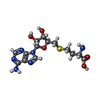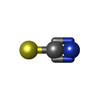[English] 日本語
 Yorodumi
Yorodumi- PDB-6j9j: crystal structure of SESTD2 in complex with H3.3S31phK36M peptide -
+ Open data
Open data
- Basic information
Basic information
| Entry | Database: PDB / ID: 6j9j | ||||||
|---|---|---|---|---|---|---|---|
| Title | crystal structure of SESTD2 in complex with H3.3S31phK36M peptide | ||||||
 Components Components |
| ||||||
 Keywords Keywords |  TRANSFERASE / TRANSFERASE /  Methyltransferase Methyltransferase | ||||||
| Function / homology |  Function and homology information Function and homology informationmesoderm morphogenesis / coronary vasculature morphogenesis / morphogenesis of a branching structure / peptidyl-lysine trimethylation / cell migration involved in vasculogenesis / microtubule cytoskeleton organization involved in mitosis / [histone H3]-lysine36 N-trimethyltransferase / histone H3K36 trimethyltransferase activity / embryonic placenta morphogenesis / regulation of mRNA export from nucleus ...mesoderm morphogenesis / coronary vasculature morphogenesis / morphogenesis of a branching structure / peptidyl-lysine trimethylation / cell migration involved in vasculogenesis / microtubule cytoskeleton organization involved in mitosis / [histone H3]-lysine36 N-trimethyltransferase / histone H3K36 trimethyltransferase activity / embryonic placenta morphogenesis / regulation of mRNA export from nucleus / pericardium development / negative regulation of chromosome condensation /  Barr body / regulation of centromere complex assembly / stem cell development / nucleosome organization / histone H3K36 methyltransferase activity / muscle cell differentiation / pericentric heterochromatin formation / inner kinetochore / protein-lysine N-methyltransferase activity / response to type I interferon / embryonic cranial skeleton morphogenesis / positive regulation of ossification / response to alkaloid / regulation of protein localization to chromatin / response to metal ion / histone H3 methyltransferase activity / Barr body / regulation of centromere complex assembly / stem cell development / nucleosome organization / histone H3K36 methyltransferase activity / muscle cell differentiation / pericentric heterochromatin formation / inner kinetochore / protein-lysine N-methyltransferase activity / response to type I interferon / embryonic cranial skeleton morphogenesis / positive regulation of ossification / response to alkaloid / regulation of protein localization to chromatin / response to metal ion / histone H3 methyltransferase activity /  oocyte maturation / regulation of double-strand break repair via homologous recombination / oocyte maturation / regulation of double-strand break repair via homologous recombination /  nucleus organization / endodermal cell differentiation / alpha-tubulin binding / spermatid development / single fertilization / subtelomeric heterochromatin formation / positive regulation of interferon-alpha production / nucleosomal DNA binding / RNA polymerase II core promoter sequence-specific DNA binding / nucleus organization / endodermal cell differentiation / alpha-tubulin binding / spermatid development / single fertilization / subtelomeric heterochromatin formation / positive regulation of interferon-alpha production / nucleosomal DNA binding / RNA polymerase II core promoter sequence-specific DNA binding /  mismatch repair / Replacement of protamines by nucleosomes in the male pronucleus / positive regulation of autophagy / forebrain development / Inhibition of DNA recombination at telomere / telomere organization / mismatch repair / Replacement of protamines by nucleosomes in the male pronucleus / positive regulation of autophagy / forebrain development / Inhibition of DNA recombination at telomere / telomere organization /  embryo implantation / RNA Polymerase I Promoter Opening / Assembly of the ORC complex at the origin of replication / embryo implantation / RNA Polymerase I Promoter Opening / Assembly of the ORC complex at the origin of replication /  DNA methylation / DNA methylation /  Transferases; Transferring one-carbon groups; Methyltransferases / Condensation of Prophase Chromosomes / ERCC6 (CSB) and EHMT2 (G9a) positively regulate rRNA expression / SIRT1 negatively regulates rRNA expression / Chromatin modifications during the maternal to zygotic transition (MZT) / Transferases; Transferring one-carbon groups; Methyltransferases / Condensation of Prophase Chromosomes / ERCC6 (CSB) and EHMT2 (G9a) positively regulate rRNA expression / SIRT1 negatively regulates rRNA expression / Chromatin modifications during the maternal to zygotic transition (MZT) /  regulation of cytokinesis / PRC2 methylates histones and DNA / Defective pyroptosis / neural tube closure / transcription elongation by RNA polymerase II / regulation of cytokinesis / PRC2 methylates histones and DNA / Defective pyroptosis / neural tube closure / transcription elongation by RNA polymerase II /  stem cell differentiation / RNA Polymerase I Promoter Escape / Transcriptional regulation by small RNAs / Formation of the beta-catenin:TCF transactivating complex / RUNX1 regulates genes involved in megakaryocyte differentiation and platelet function / Activated PKN1 stimulates transcription of AR (androgen receptor) regulated genes KLK2 and KLK3 / NoRC negatively regulates rRNA expression / B-WICH complex positively regulates rRNA expression / multicellular organism growth / response to organic cyclic compound / PKMTs methylate histone lysines / stem cell differentiation / RNA Polymerase I Promoter Escape / Transcriptional regulation by small RNAs / Formation of the beta-catenin:TCF transactivating complex / RUNX1 regulates genes involved in megakaryocyte differentiation and platelet function / Activated PKN1 stimulates transcription of AR (androgen receptor) regulated genes KLK2 and KLK3 / NoRC negatively regulates rRNA expression / B-WICH complex positively regulates rRNA expression / multicellular organism growth / response to organic cyclic compound / PKMTs methylate histone lysines /  Meiotic recombination / Pre-NOTCH Transcription and Translation / Activation of anterior HOX genes in hindbrain development during early embryogenesis / osteoblast differentiation / Transcriptional regulation of granulopoiesis / structural constituent of chromatin / male gonad development / Meiotic recombination / Pre-NOTCH Transcription and Translation / Activation of anterior HOX genes in hindbrain development during early embryogenesis / osteoblast differentiation / Transcriptional regulation of granulopoiesis / structural constituent of chromatin / male gonad development /  nucleosome / nucleosome /  nucleosome assembly / nucleosome assembly /  chromosome / RUNX1 regulates transcription of genes involved in differentiation of HSCs / Factors involved in megakaryocyte development and platelet production / Senescence-Associated Secretory Phenotype (SASP) / positive regulation of cell growth / chromosome / RUNX1 regulates transcription of genes involved in differentiation of HSCs / Factors involved in megakaryocyte development and platelet production / Senescence-Associated Secretory Phenotype (SASP) / positive regulation of cell growth /  regulation of gene expression / Oxidative Stress Induced Senescence / regulation of gene expression / Oxidative Stress Induced Senescence /  angiogenesis / defense response to virus / Estrogen-dependent gene expression / cell population proliferation / angiogenesis / defense response to virus / Estrogen-dependent gene expression / cell population proliferation /  chromosome, telomeric region / RNA polymerase II cis-regulatory region sequence-specific DNA binding / protein heterodimerization activity / Amyloid fiber formation / regulation of DNA-templated transcription / protein-containing complex / extracellular exosome / extracellular region / chromosome, telomeric region / RNA polymerase II cis-regulatory region sequence-specific DNA binding / protein heterodimerization activity / Amyloid fiber formation / regulation of DNA-templated transcription / protein-containing complex / extracellular exosome / extracellular region /  nucleoplasm / nucleoplasm /  metal ion binding metal ion bindingSimilarity search - Function | ||||||
| Biological species |   Homo sapiens (human) Homo sapiens (human) | ||||||
| Method |  X-RAY DIFFRACTION / X-RAY DIFFRACTION /  SYNCHROTRON / Resolution: 1.78 Å SYNCHROTRON / Resolution: 1.78 Å | ||||||
 Authors Authors | Yang, S. / Li, H.T. | ||||||
 Citation Citation |  Journal: Nature / Year: 2020 Journal: Nature / Year: 2020Title: Histone H3.3 phosphorylation amplifies stimulation-induced transcription. Authors: Armache, A. / Yang, S. / Martinez de Paz, A. / Robbins, L.E. / Durmaz, C. / Cheong, J.Q. / Ravishankar, A. / Daman, A.W. / Ahimovic, D.J. / Klevorn, T. / Yue, Y. / Arslan, T. / Lin, S. / ...Authors: Armache, A. / Yang, S. / Martinez de Paz, A. / Robbins, L.E. / Durmaz, C. / Cheong, J.Q. / Ravishankar, A. / Daman, A.W. / Ahimovic, D.J. / Klevorn, T. / Yue, Y. / Arslan, T. / Lin, S. / Panchenko, T. / Hrit, J. / Wang, M. / Thudium, S. / Garcia, B.A. / Korb, E. / Armache, K.J. / Rothbart, S.B. / Hake, S.B. / Allis, C.D. / Li, H. / Josefowicz, S.Z. | ||||||
| History |
|
- Structure visualization
Structure visualization
| Structure viewer | Molecule:  Molmil Molmil Jmol/JSmol Jmol/JSmol |
|---|
- Downloads & links
Downloads & links
- Download
Download
| PDBx/mmCIF format |  6j9j.cif.gz 6j9j.cif.gz | 73.4 KB | Display |  PDBx/mmCIF format PDBx/mmCIF format |
|---|---|---|---|---|
| PDB format |  pdb6j9j.ent.gz pdb6j9j.ent.gz | 54.7 KB | Display |  PDB format PDB format |
| PDBx/mmJSON format |  6j9j.json.gz 6j9j.json.gz | Tree view |  PDBx/mmJSON format PDBx/mmJSON format | |
| Others |  Other downloads Other downloads |
-Validation report
| Arichive directory |  https://data.pdbj.org/pub/pdb/validation_reports/j9/6j9j https://data.pdbj.org/pub/pdb/validation_reports/j9/6j9j ftp://data.pdbj.org/pub/pdb/validation_reports/j9/6j9j ftp://data.pdbj.org/pub/pdb/validation_reports/j9/6j9j | HTTPS FTP |
|---|
-Related structure data
| Similar structure data |
|---|
- Links
Links
- Assembly
Assembly
| Deposited unit | 
| ||||||||
|---|---|---|---|---|---|---|---|---|---|
| 1 |
| ||||||||
| Unit cell |
|
- Components
Components
-Protein / Protein/peptide , 2 types, 2 molecules AB
| #1: Protein | Mass: 29695.824 Da / Num. of mol.: 1 Source method: isolated from a genetically manipulated source Source: (gene. exp.)   Homo sapiens (human) / Gene: SETD2, HIF1, HYPB, KIAA1732, KMT3A, SET2, HSPC069 / Production host: Homo sapiens (human) / Gene: SETD2, HIF1, HYPB, KIAA1732, KMT3A, SET2, HSPC069 / Production host:   Escherichia coli (E. coli) Escherichia coli (E. coli)References: UniProt: Q9BYW2,  histone-lysine N-methyltransferase, histone-lysine N-methyltransferase,  Transferases; Transferring one-carbon groups; Methyltransferases Transferases; Transferring one-carbon groups; Methyltransferases |
|---|---|
| #2: Protein/peptide | Mass: 1640.801 Da / Num. of mol.: 1 / Source method: obtained synthetically / Source: (synth.)   Homo sapiens (human) / References: UniProt: P84243*PLUS Homo sapiens (human) / References: UniProt: P84243*PLUS |
-Non-polymers , 4 types, 268 molecules 






| #3: Chemical | | #4: Chemical | ChemComp-SAH / |  S-Adenosyl-L-homocysteine S-Adenosyl-L-homocysteine#5: Chemical | ChemComp-SCN /  Thiocyanate Thiocyanate#6: Water | ChemComp-HOH / |  Water Water |
|---|
-Experimental details
-Experiment
| Experiment | Method:  X-RAY DIFFRACTION / Number of used crystals: 1 X-RAY DIFFRACTION / Number of used crystals: 1 |
|---|
- Sample preparation
Sample preparation
| Crystal | Density Matthews: 3.03 Å3/Da / Density % sol: 59.4 % |
|---|---|
Crystal grow | Temperature: 277 K / Method: vapor diffusion, sitting drop / pH: 8.5 Details: 0.2M potassium thiocyanate, 0.1M Bis-Tris propane,20% PEG 3350 |
-Data collection
| Diffraction | Mean temperature: 100 K / Serial crystal experiment: N | |||||||||||||||||||||||||||||||||||||||||||||||||||||||||||||||||||||||||||||||||||||||||||||||||||||||||||||||||||||||||||||||||||||||||||||||||||||||||||||||||||||||||||||||||||||||||||||
|---|---|---|---|---|---|---|---|---|---|---|---|---|---|---|---|---|---|---|---|---|---|---|---|---|---|---|---|---|---|---|---|---|---|---|---|---|---|---|---|---|---|---|---|---|---|---|---|---|---|---|---|---|---|---|---|---|---|---|---|---|---|---|---|---|---|---|---|---|---|---|---|---|---|---|---|---|---|---|---|---|---|---|---|---|---|---|---|---|---|---|---|---|---|---|---|---|---|---|---|---|---|---|---|---|---|---|---|---|---|---|---|---|---|---|---|---|---|---|---|---|---|---|---|---|---|---|---|---|---|---|---|---|---|---|---|---|---|---|---|---|---|---|---|---|---|---|---|---|---|---|---|---|---|---|---|---|---|---|---|---|---|---|---|---|---|---|---|---|---|---|---|---|---|---|---|---|---|---|---|---|---|---|---|---|---|---|---|---|---|---|
| Diffraction source | Source:  SYNCHROTRON / Site: SYNCHROTRON / Site:  SSRF SSRF  / Beamline: BL17U1 / Wavelength: 0.9792 Å / Beamline: BL17U1 / Wavelength: 0.9792 Å | |||||||||||||||||||||||||||||||||||||||||||||||||||||||||||||||||||||||||||||||||||||||||||||||||||||||||||||||||||||||||||||||||||||||||||||||||||||||||||||||||||||||||||||||||||||||||||||
| Detector | Type: ADSC QUANTUM 315r / Detector: CCD / Date: May 8, 2015 | |||||||||||||||||||||||||||||||||||||||||||||||||||||||||||||||||||||||||||||||||||||||||||||||||||||||||||||||||||||||||||||||||||||||||||||||||||||||||||||||||||||||||||||||||||||||||||||
| Radiation | Protocol: SINGLE WAVELENGTH / Monochromatic (M) / Laue (L): M / Scattering type: x-ray | |||||||||||||||||||||||||||||||||||||||||||||||||||||||||||||||||||||||||||||||||||||||||||||||||||||||||||||||||||||||||||||||||||||||||||||||||||||||||||||||||||||||||||||||||||||||||||||
| Radiation wavelength | Wavelength : 0.9792 Å / Relative weight: 1 : 0.9792 Å / Relative weight: 1 | |||||||||||||||||||||||||||||||||||||||||||||||||||||||||||||||||||||||||||||||||||||||||||||||||||||||||||||||||||||||||||||||||||||||||||||||||||||||||||||||||||||||||||||||||||||||||||||
| Reflection | Resolution: 1.78→50 Å / Num. obs: 35792 / % possible obs: 99.8 % / Redundancy: 6.5 % / Rmerge(I) obs: 0.075 / Rpim(I) all: 0.032 / Rrim(I) all: 0.082 / Χ2: 0.964 / Net I/σ(I): 6.8 / Num. measured all: 233252 | |||||||||||||||||||||||||||||||||||||||||||||||||||||||||||||||||||||||||||||||||||||||||||||||||||||||||||||||||||||||||||||||||||||||||||||||||||||||||||||||||||||||||||||||||||||||||||||
| Reflection shell | Diffraction-ID: 1
|
- Processing
Processing
| Software |
| ||||||||||||||||||||||||
|---|---|---|---|---|---|---|---|---|---|---|---|---|---|---|---|---|---|---|---|---|---|---|---|---|---|
| Refinement | Resolution: 1.78→48.01 Å / Cor.coef. Fo:Fc: 0.956 / Cor.coef. Fo:Fc free: 0.95 / SU B: 0.004 / SU ML: 0 / Cross valid method: THROUGHOUT / σ(F): 0 / ESU R: 0.091 / ESU R Free: 0.099 / Stereochemistry target values: MAXIMUM LIKELIHOOD Details: HYDROGENS HAVE BEEN ADDED IN THE RIDING POSITIONS U VALUES : REFINED INDIVIDUALLY
| ||||||||||||||||||||||||
| Solvent computation | Ion probe radii: 0.8 Å / Shrinkage radii: 0.8 Å / VDW probe radii: 1.2 Å / Solvent model: MASK | ||||||||||||||||||||||||
| Displacement parameters | Biso max: 80.69 Å2 / Biso mean: 31.201 Å2 / Biso min: 15.29 Å2
| ||||||||||||||||||||||||
| Refinement step | Cycle: final / Resolution: 1.78→48.01 Å
| ||||||||||||||||||||||||
| LS refinement shell | Resolution: 1.779→1.825 Å / Rfactor Rfree error: 0 / Total num. of bins used: 20
|
 Movie
Movie Controller
Controller












 PDBj
PDBj












